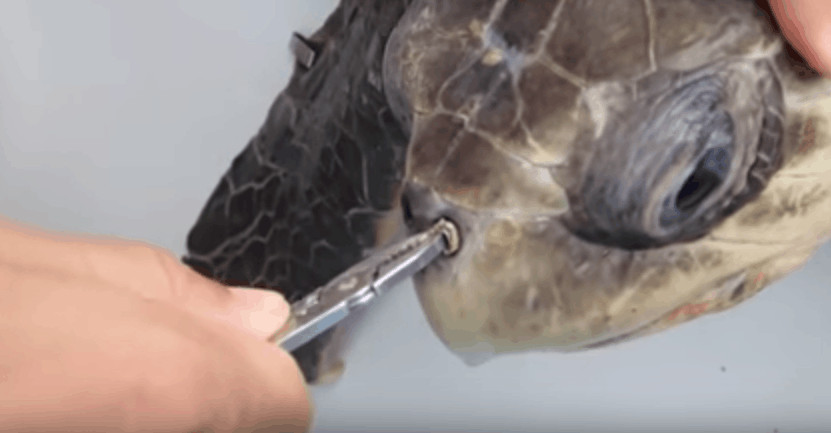If this doesn’t make you rethink accepting that plastic straw the waitress offers you next time you’re at a café, nothing will. A turtle researcher recently posted a video on YouTube of her colleague removing a plastic drinking straw from the nostril of an olive ridley sea turtle off the Pacific coast of Costa Rica.
At the start of the video, a hand holding a pair of small pliers begins to tug on the end of something whitish lodged into the turtle’s left nostril, flush with the skin. As the turtle’s would-be savior struggles to dislodge the object, the turtle snorts, it bleeds, it blinks its big, sad eyes.
At first the researchers think it’s a parasitic worm, but then they snip off the small piece that they’ve managed to pull out of the turtle’s nose and cut it open with the scissors on a Swiss army knife. Four minutes into the video, a man off camera says in Spanish, “Es plástico.”
“¿Plástico?” the woman filming asks. “Is it a straw? Don’t tell me it’s a freaking straw.” The woman filming is Christine Figgener, a second year marine biology PhD student at Texas A&M University. Her colleague with the pliers is Nathan J. Robinson, a post-doctoral fellow at Indiana-Purdue University.
They soon determine that it is, indeed, a straw. Finally, after nearly eight painful minutes of pulling on the end of the straw, it comes loose. It’s a full-length drinking straw — 10 to 12 centimeters long, Figgener wrote in the description of her YouTube video. She said the turtle likely ingested the straw and then puked it up out of the wrong passageway.
“The nasal cavity of sea turtles is connected directly to the palate (roof of the mouth) by a long nasopharyngeal duct,” Figgener wrote. The turtle was OK, as far as the researchers know. Figgener wrote that the bleeding stopped almost immediately after removing the straw. She said they treated the nasal passage with iodine and later released the patient back into the ocean.
Freakin’ plastic
The number of F-bombs Figgener drops throughout the video — most of them after she finds out the turtle is a victim of our ubiquitous plastic trash problem — is indicative of her feelings on the subject.
The YouTube video of the straw removal had been viewed more than 3.3 million times by Tuesday morning, August 18. After viewers asked how they could help, Figgener started a GoFundMe campaign to support her sea turtle research.
Figgener plans to spend at least some of the cash on developing a sea turtle first aid kit, according to a Tuesday update on the fundraising site.
“The first aid kit would be for cases like ours where a sea turtle is found with injuries or foreign objects attached to them, such as fishing hooks or fishing line or -as in in our case – a straw, and medical attention is unavailable or too far away,” Figgener wrote on the site.
.








